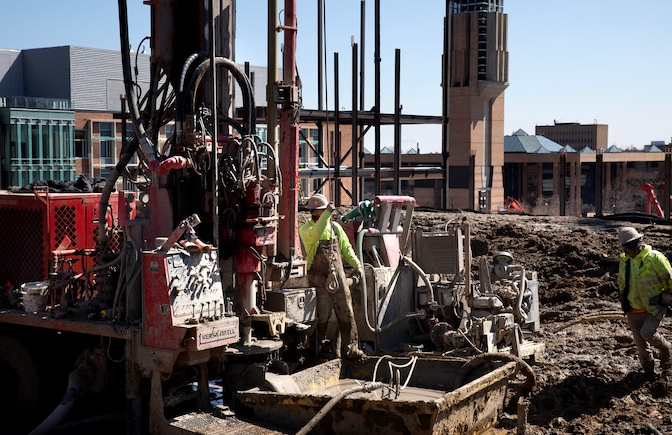
Geothermal at Davos: a Q&A with Karthik Duraisamy
Karthik Duraisamy, a University of Michigan professor of aerospace engineering, participated in a roundtable on geothermal energy at the World Economic Forum.

Karthik Duraisamy, a University of Michigan professor of aerospace engineering, participated in a roundtable on geothermal energy at the World Economic Forum.
Experts
The annual meeting of the World Economic Forum was held this week in Davos-Klosters, Switzerland, bringing together leaders in business and government as well as other experts. One of these was Karthik Duraisamy, a professor of aerospace engineering whose start-up company Geminus just announced bringing in $13 million in Series A funding.
He was invited to participate in a roundtable of thought leaders in the energy transition, focusing on geothermal energy. Geothermal systems harness heat energy underground for heating and cooling applications or in some cases, to generate electricity.
The panel included the the CEO of the International Geothermal Association, the leader of Switzerland’s geothermal energy activities, and leaders from the International Energy Agency, ThinkGeoEnergy, Innargi, Eavor and the UN Environment Program. It was moderated by author and senior reporter for climate at Bloomberg Akshat Rathi.
Duraisamy brought deep knowledge of computational modeling and AI. As director of the Michigan Institute for Computational Discovery and Engineering, he leads efforts at the University of Michigan to define a future in which computations offer solutions to grand challenge problems faced by science and society. Part of his own work is focused on making the most of incomplete and imperfect data sets, combining them with physics-based modeling to make accurate predictions of complex, real-world systems.
He also brought experience as the founder and chief scientist of a Silicon Valley startup, which focuses on enabling the creation of smart digital twins to enhance industrial efficiency, reliability and performance.
The international community has made good strides in geothermal energy over the past decade, and the US is one of the leaders. However, geothermal energy sources are vastly under-utilized in every country in the world, barring a few exceptions—Iceland, New Zealand and Kenya.
In the US, geothermal sources account for less than half a percent of electricity generation, and despite its effectiveness and consistent availability, less than 2 million homes and buildings use geothermal heating and cooling. There are great opportunities to increase these numbers by at least a factor of 10, and for geothermal to be a much more significant part of the transition to renewable energy that is currently underway.
The big technical challenge is the expense of drilling, which increases capital costs. We could reduce that cost by better characterizing subsurface information and providing predictive modeling and optimization tools. On the social side, we need more awareness about the benefits of geothermal energy as well as consistent governmental policies and regulations.
It was a pleasure to discuss geothermal energy with the world leaders in this field. We touched upon a variety of topics, including investments in sustainable energy, the policy and regulatory environments and social awareness and acceptance.
I learned that the EU and individual countries have seen the positive impact some recent legislation in our country has had on the sustainable energy transition and are considering similarly impactful incentives. As an academic, it was also particularly intriguing to hear concerns from the group over losing current and future students in geological sciences and engineering because ‘subsurface’ has been traditionally associated with fossil fuels, which have a bad rap.
I added my perspectives on how computational modeling, digital twins and AI can help improve efficiencies and reduce costs, with some examples from Geminus’ work in subsurface modeling and optimization of geothermal systems. I also brought an academic perspective, as our colleagues in the Michigan Institute for Computational Discovery and Engineering and the Center for Sustainable Systems have done quite a bit of work in related areas.
One of the points I made is that AI and digital twins shouldn’t just be seen as a solution for engineering problems. Digitalization can greatly help align the technology with its management, rigorously inform policy and regulations, and interact with supply chains, market analysis and social acceptance. In other words, digital twins can be a unifier and an end-to-end solution for these seemingly disparate tasks.
Because of the prevailing environmental and geopolitical factors, there is a huge push towards sustainable energy systems, and geothermal has great appeal in that it is extremely efficient for heating and cooling. We input 1 unit of energy to get 4 units of heat! Compared to wind and solar, this is a more stable and less variable source of energy.
There are also new opportunities in repurposing depleted oil wells and coal plants for geothermal use. Just as the cost of wind and solar energy have dropped dramatically over the past two decades, geothermal can as well. In fact, some new developments in drilling for oil & gas have led to some breakthroughs in drilling for geothermal energy sources.
Fundamentally, sustainable energy is not just about energy security and battling climate change. It also makes genuine sense from an economic standpoint. In fact, Akshat Rathi argues in his book, an excellent read, that “it is cheaper to save the world than to destroy it.“